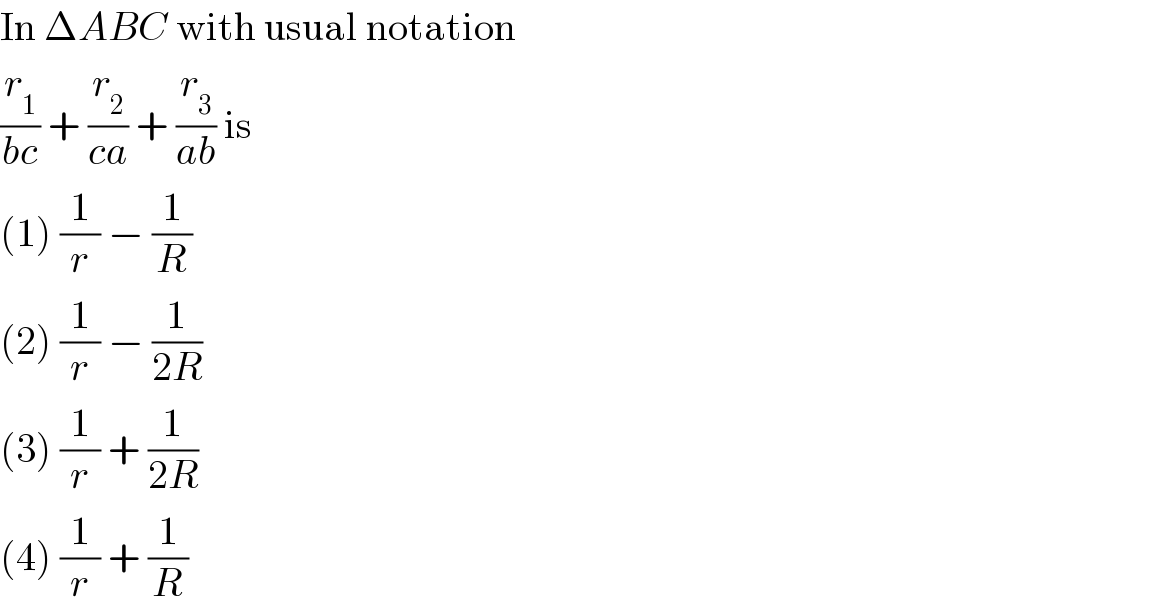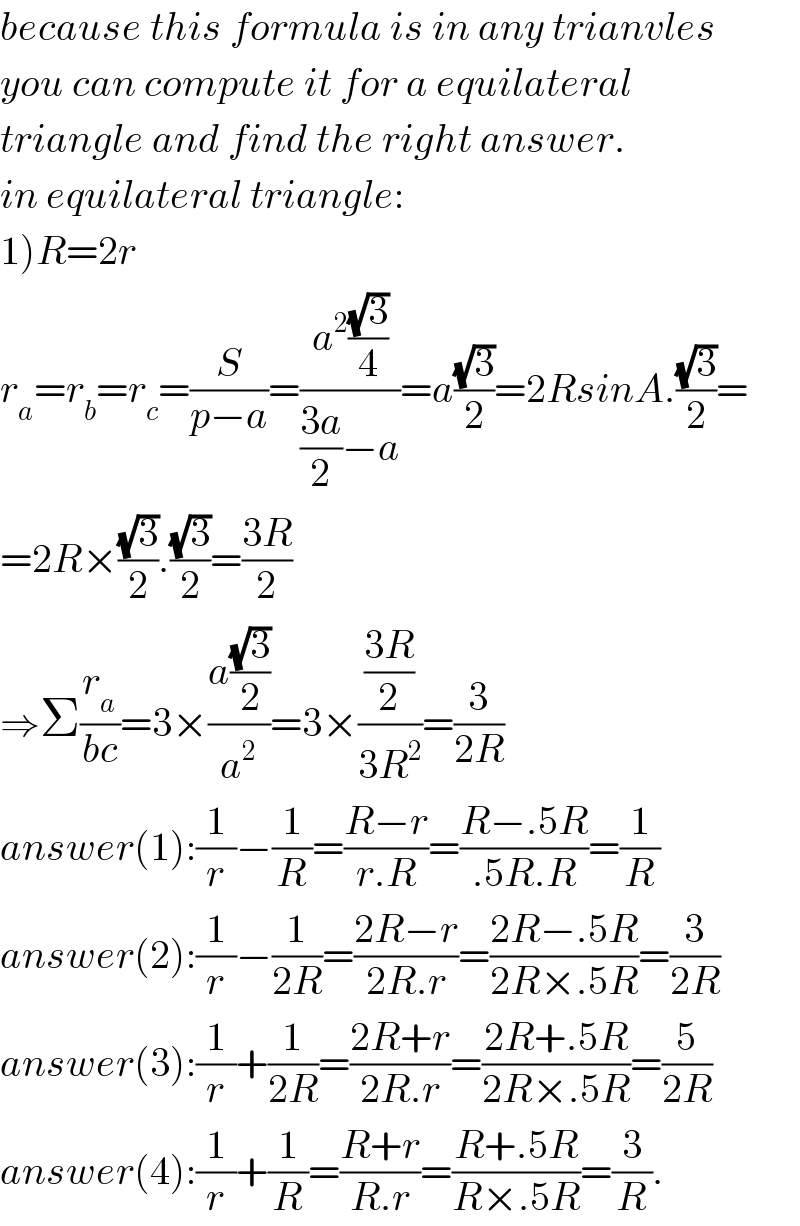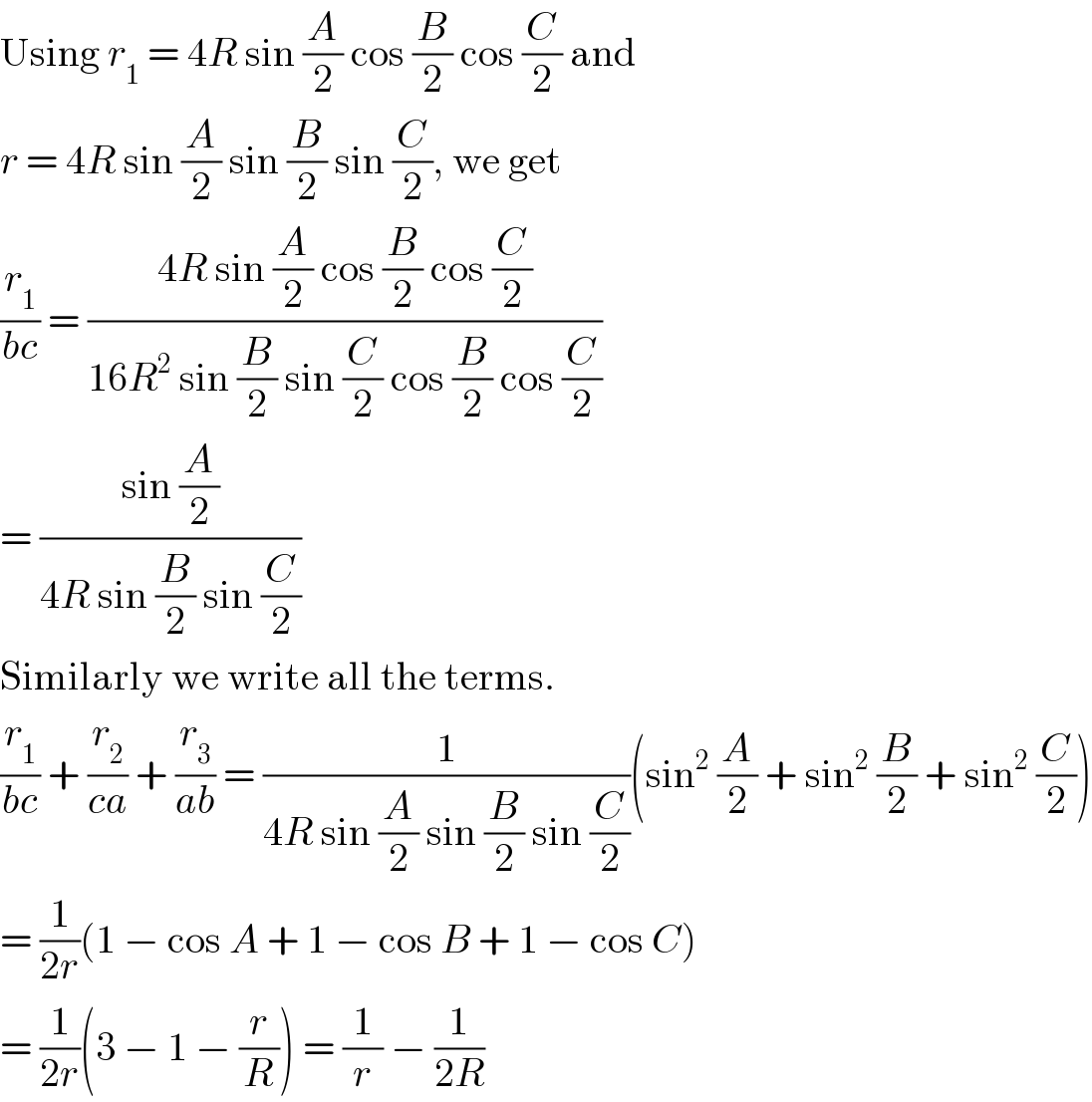
Question Number 16430 by Tinkutara last updated on 22/Jun/17

$$\mathrm{In}\:\Delta{ABC}\:\mathrm{with}\:\mathrm{usual}\:\mathrm{notation} \\ $$$$\frac{{r}_{\mathrm{1}} }{{bc}}\:+\:\frac{{r}_{\mathrm{2}} }{{ca}}\:+\:\frac{{r}_{\mathrm{3}} }{{ab}}\:\mathrm{is} \\ $$$$\left(\mathrm{1}\right)\:\frac{\mathrm{1}}{{r}}\:−\:\frac{\mathrm{1}}{{R}} \\ $$$$\left(\mathrm{2}\right)\:\frac{\mathrm{1}}{{r}}\:−\:\frac{\mathrm{1}}{\mathrm{2}{R}} \\ $$$$\left(\mathrm{3}\right)\:\frac{\mathrm{1}}{{r}}\:+\:\frac{\mathrm{1}}{\mathrm{2}{R}} \\ $$$$\left(\mathrm{4}\right)\:\frac{\mathrm{1}}{{r}}\:+\:\frac{\mathrm{1}}{{R}} \\ $$
Commented by b.e.h.i.8.3.4.1.7@gmail.com last updated on 22/Jun/17

$${answer}\:\left(\mathrm{2}\right)\: \\ $$
Commented by b.e.h.i.8.3.4.1.7@gmail.com last updated on 23/Jun/17

$${because}\:{this}\:{formula}\:{is}\:{in}\:{any}\:{trianvles} \\ $$$${you}\:{can}\:{compute}\:{it}\:{for}\:{a}\:{equilateral} \\ $$$${triangle}\:{and}\:{find}\:{the}\:{right}\:{answer}. \\ $$$${in}\:{equilateral}\:{triangle}: \\ $$$$\left.\mathrm{1}\right){R}=\mathrm{2}{r} \\ $$$${r}_{{a}} ={r}_{{b}} ={r}_{{c}} =\frac{{S}}{{p}−{a}}=\frac{{a}^{\mathrm{2}} \frac{\sqrt{\mathrm{3}}}{\mathrm{4}}}{\frac{\mathrm{3}{a}}{\mathrm{2}}−{a}}={a}\frac{\sqrt{\mathrm{3}}}{\mathrm{2}}=\mathrm{2}{RsinA}.\frac{\sqrt{\mathrm{3}}}{\mathrm{2}}= \\ $$$$=\mathrm{2}{R}×\frac{\sqrt{\mathrm{3}}}{\mathrm{2}}.\frac{\sqrt{\mathrm{3}}}{\mathrm{2}}=\frac{\mathrm{3}{R}}{\mathrm{2}} \\ $$$$\Rightarrow\Sigma\frac{{r}_{{a}} }{{bc}}=\mathrm{3}×\frac{{a}\frac{\sqrt{\mathrm{3}}}{\mathrm{2}}}{{a}^{\mathrm{2}} }=\mathrm{3}×\frac{\frac{\mathrm{3}{R}}{\mathrm{2}}}{\mathrm{3}{R}^{\mathrm{2}} }=\frac{\mathrm{3}}{\mathrm{2}{R}} \\ $$$${answer}\left(\mathrm{1}\right):\frac{\mathrm{1}}{{r}}−\frac{\mathrm{1}}{{R}}=\frac{{R}−{r}}{{r}.{R}}=\frac{{R}−.\mathrm{5}{R}}{.\mathrm{5}{R}.{R}}=\frac{\mathrm{1}}{{R}} \\ $$$${answer}\left(\mathrm{2}\right):\frac{\mathrm{1}}{{r}}−\frac{\mathrm{1}}{\mathrm{2}{R}}=\frac{\mathrm{2}{R}−{r}}{\mathrm{2}{R}.{r}}=\frac{\mathrm{2}{R}−.\mathrm{5}{R}}{\mathrm{2}{R}×.\mathrm{5}{R}}=\frac{\mathrm{3}}{\mathrm{2}{R}} \\ $$$${answer}\left(\mathrm{3}\right):\frac{\mathrm{1}}{{r}}+\frac{\mathrm{1}}{\mathrm{2}{R}}=\frac{\mathrm{2}{R}+{r}}{\mathrm{2}{R}.{r}}=\frac{\mathrm{2}{R}+.\mathrm{5}{R}}{\mathrm{2}{R}×.\mathrm{5}{R}}=\frac{\mathrm{5}}{\mathrm{2}{R}} \\ $$$${answer}\left(\mathrm{4}\right):\frac{\mathrm{1}}{{r}}+\frac{\mathrm{1}}{{R}}=\frac{{R}+{r}}{{R}.{r}}=\frac{{R}+.\mathrm{5}{R}}{{R}×.\mathrm{5}{R}}=\frac{\mathrm{3}}{{R}}. \\ $$
Answered by Tinkutara last updated on 06/Jul/17

$$\mathrm{Using}\:{r}_{\mathrm{1}} \:=\:\mathrm{4}{R}\:\mathrm{sin}\:\frac{{A}}{\mathrm{2}}\:\mathrm{cos}\:\frac{{B}}{\mathrm{2}}\:\mathrm{cos}\:\frac{{C}}{\mathrm{2}}\:\mathrm{and} \\ $$$${r}\:=\:\mathrm{4}{R}\:\mathrm{sin}\:\frac{{A}}{\mathrm{2}}\:\mathrm{sin}\:\frac{{B}}{\mathrm{2}}\:\mathrm{sin}\:\frac{{C}}{\mathrm{2}},\:\mathrm{we}\:\mathrm{get} \\ $$$$\frac{{r}_{\mathrm{1}} }{{bc}}\:=\:\frac{\mathrm{4}{R}\:\mathrm{sin}\:\frac{{A}}{\mathrm{2}}\:\mathrm{cos}\:\frac{{B}}{\mathrm{2}}\:\mathrm{cos}\:\frac{{C}}{\mathrm{2}}}{\mathrm{16}{R}^{\mathrm{2}} \:\mathrm{sin}\:\frac{{B}}{\mathrm{2}}\:\mathrm{sin}\:\frac{{C}}{\mathrm{2}}\:\mathrm{cos}\:\frac{{B}}{\mathrm{2}}\:\mathrm{cos}\:\frac{{C}}{\mathrm{2}}} \\ $$$$=\:\frac{\mathrm{sin}\:\frac{{A}}{\mathrm{2}}}{\mathrm{4}{R}\:\mathrm{sin}\:\frac{{B}}{\mathrm{2}}\:\mathrm{sin}\:\frac{{C}}{\mathrm{2}}} \\ $$$$\mathrm{Similarly}\:\mathrm{we}\:\mathrm{write}\:\mathrm{all}\:\mathrm{the}\:\mathrm{terms}. \\ $$$$\frac{{r}_{\mathrm{1}} }{{bc}}\:+\:\frac{{r}_{\mathrm{2}} }{{ca}}\:+\:\frac{{r}_{\mathrm{3}} }{{ab}}\:=\:\frac{\mathrm{1}}{\mathrm{4}{R}\:\mathrm{sin}\:\frac{{A}}{\mathrm{2}}\:\mathrm{sin}\:\frac{{B}}{\mathrm{2}}\:\mathrm{sin}\:\frac{{C}}{\mathrm{2}}}\left(\mathrm{sin}^{\mathrm{2}} \:\frac{{A}}{\mathrm{2}}\:+\:\mathrm{sin}^{\mathrm{2}} \:\frac{{B}}{\mathrm{2}}\:+\:\mathrm{sin}^{\mathrm{2}} \:\frac{{C}}{\mathrm{2}}\right) \\ $$$$=\:\frac{\mathrm{1}}{\mathrm{2}{r}}\left(\mathrm{1}\:−\:\mathrm{cos}\:{A}\:+\:\mathrm{1}\:−\:\mathrm{cos}\:{B}\:+\:\mathrm{1}\:−\:\mathrm{cos}\:{C}\right) \\ $$$$=\:\frac{\mathrm{1}}{\mathrm{2}{r}}\left(\mathrm{3}\:−\:\mathrm{1}\:−\:\frac{{r}}{{R}}\right)\:=\:\frac{\mathrm{1}}{{r}}\:−\:\frac{\mathrm{1}}{\mathrm{2}{R}} \\ $$
